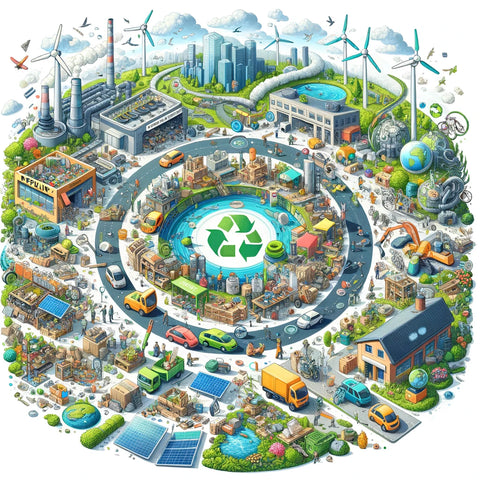Maximizing Value: The Circular Economy Model
Revolutionizing Sustainability: The Circular Economy Model Explained
Circular Economy
By reusing and recycling goods and components and maximizing their value during their useful lives, as well as by recovering, reusing, and recycling them after they have served their purpose, circular economy models aim to revolutionize production and consumption. The old linear economy, in contrast to this model, is resource-intensive since it follows the 'take-make-dispose' cycle.
There are three main ideas that support the circular economy:
Reduce or eliminate pollution and waste from the start by reevaluating product design, production, and consumption. To achieve this goal, items must be designed with reusability, durability, and ease of disassembly and repurposing in mind.
This idea emphasizes the need of extending the useful life of products and materials in order to preserve their value. To prolong the useful life of goods and their components, it employs techniques including repair, refurbishing, remanufacturing, and finally recycling.
The goal of the circular economy is not just to reduce environmental damage, but to improve natural systems by encouraging actions that reinvigorate them. Some examples of this include bolstering biodiversity, using sustainable energy, and regenerative farming techniques.
Any industry or size, from individual items to large cities, may benefit from adopting circular economy ideas. They alleviate strain on natural resources, decrease emissions of greenhouse gases, encourage innovation, and provide new employment possibilities, among other substantial economic, environmental, and social advantages.
Circular economy techniques may be shown in the following examples:
Product as a Service (PaaS): Customers can get their hands on items through methods like leasing or sharing rather than purchasing them outright. Since the manufacturer is still responsible for the product throughout its existence, they are more likely to make long-lasting, easy-to-maintain items.
The utilization of modern sorting and recycling technologies enables the recovery of materials and their subsequent reintroduction into the production cycle, therefore decreasing the need for raw resources.
Companies that are geographically near together engage in industrial symbiosis when they trade energy and surplus materials, therefore reusing and recycling resources.
All parties involved, including companies, governments, and consumers, need to change their perspective in order to embrace models of the circular economy. It seeks to bring about a systemic shift towards sustainability by reevaluating design processes, business structures, and consumption habits.






I had unprotected oral sex and intercourse. Two days later I experienced a burning, itching sensation in my genitals as well as left lower abdonimal pain. It felt like a small bump inside my vagina. The bump was almost like an ingrown hair but not painful and disapeared within two days. The doctor said it didn’t not look like herpes despite the other symptoms i was experiencing. 6 days after exposure i had an igG done that tested for active herpes 1. I was told it will remain with me forever and i should always inform my partner before intercourse. It is difficult and impossible for me to tell anyone i have hsv1 because no one will want to stay when it involves an easily transmitted infection like herpes. I decided to remain lonely and find an alternative methods that was when I saw testimonies of people Dr Utu have cured herpes
I copied the email and contacted him. I ordered the herpes herbal cleanser and he sent me a form which i filled with my detailed health history.
After filling out a detailed form regarding my condition, I felt a glimmer of hope for the first time since my diagnosis.
I wasn’t around when my herbs arrived but when I got home I started treatment immediately
Dr Utu Herbal Cure was a turning point in my life. I followed his guidance carefully, and within short moment, my symptoms began to diminish significantly. I felt healthier and more like myself again, free from the burdens of herpes.
After the completion of treatment i went for a test and my result came out hsv1 negative meaning herpes was not detectable. Anyone suffering from Hepes Virus, Shingles, or warts can reach Dr Utu at
drutuherbalcure@gmail.com for the herpes herbal cleanser it worked perfectly
Leave a comment